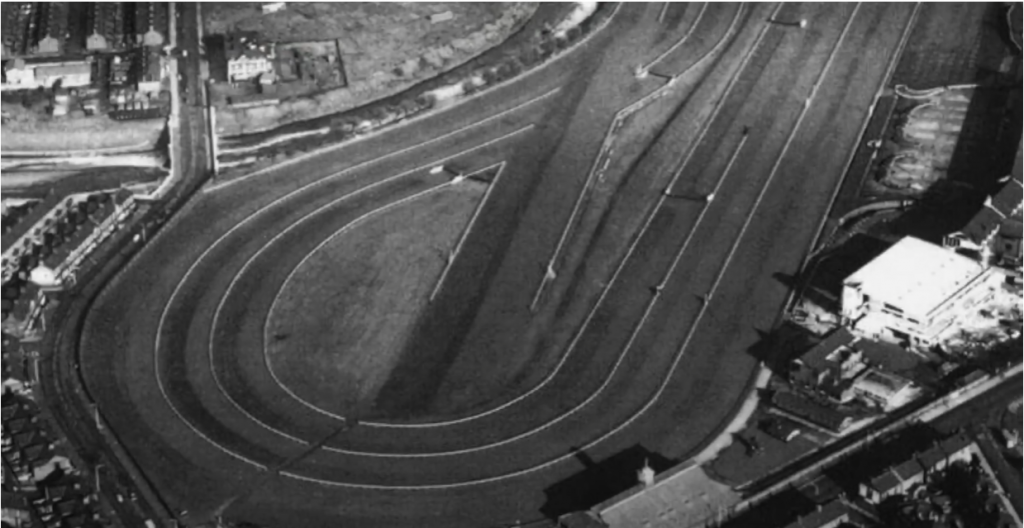
With Cheltenham underway this week, attention is thoroughly focused on the horse-racing, so we’ve been saddled with digging into the furlong-deep history of Salford’s long lost racecourses.
Known officially under the name Manchester Racecourses, the venue has known many locations over its long history with its first recorded race in Salford happening on Kersal Moor in 1687.
Until 1847 Kersal Moor remained the main location for Manchester Racecourses, only once seeing a thirteen-year hiatus thanks to Jacobite influence.
The course featured three small hills over an undulating one-mile course, that saw a grandstand built in 1777.
Such thrilling entertainment for the time meant events would often attract over 100,000 spectators during the annual Whit races, but the venue eventually closed permanently in 1847 when the Manchester Racecourse Committee’s lease ran out and was not renewed.
Racing was moved across the River Irwell to Castle Irwell, today the location of Kersal Wetlands.
Unsurprisingly for a site which today is a flood defence system, the new course was boggy and prone to adverse conditions. This did not stop a 1000-seater grandstand being built while the meander of the river provided easier management as well as a back door for fare-dodging spectators, often to the amusement of onlookers.
Salford poet and author, Richard Wright Proctor, was intrigued by the scene and inspired to write about it.
The river is also the source of occasional merriment. As the approaches to the race-ground are jealously guarded by toll-men, it follows that many urchins, penniless tramps, and artizans out of employ are annually excluded. Of these unfortunates some turn listlessly homeward, while others, more persevering, gather in groups along the bank of the stream, and select a place for fording. The youngsters then strip, and fasten their bundled apparel upon their heads; the men turn up their trousers, slinging their shoes and stockings over their shoulders ; thus prepared they enter the water, some crossing with comparative ease; but others, on dropping a cap, or swimming a stocking, or sinking deeper than they expected, lose heart and return, to the infinite amusement of those on the winning side. If, as Poor Richard affirms, a penny saved be a penny gained, this is the way to gain it with a vengeance.
When the land lease came to be renewed, son of the initial leaser John Fitzgerald, also called John, refused to renew it based on “Christian reasons.”
From here it was Weaste’s turn to take the reigns becoming the new home of horse-racing in Salford with the course being dubbed rather fittingly New Barns.
Here it hosted the Lancashire Plate from 1888 to 1893, which at the time offered the highest paying prize money in the country at an astronomical £11,000.
The year after the prize money was reduced to a still sizeable £2,000 and renamed the Prince Edward Handicap.
The Manchester Racecourse had great pedigree in the sport, traditionally being the final race of the British flat racing season.
As time went on once again the racecourse grim-reaper came calling in the form of progress as the Manchester Ship Canal Company sought powers to compulsorily purchase the land for a new dock and railway sidings.
By 1902 progress defeated entertainment in a court battle and construction began on new infrastructure.
Plans put in place to bring the stables back to Castle Irwell had been put in place in 1898 with new facilities including a club stand, gardens and club galleries opening on Easter Weekend 1902.
The inaugural race was the Lancashire Steeplechase, a race that ran until 1952.
In the 1930’s a hotel, The Racecourse, was built on Littleton Road to provide accommodation for racers and punters.
On Friday 13th July 1951, the racecourse made history becoming England’s first evening meeting, attracting a large crowd despite the timelessly unrelenting Salford weather.
Even the Queen couldn’t resist a trip to Salford for the races as June 1952 saw the first victory as monarch of the newly crowned Queen Elizabeth II.
Financial issues for the club began as the club stand was found to be suffering from rot. In response, they built a concrete stand, with it being the first stand in Britain with private boxes.
The cost of this stand put great pressure on the finances, and in 1963, the shareholders sold the site.
Castle Irwell’s final race, the Goodbye Consolation Plate, was held on the 9th November 1963, won by legendary jockey Lester Piggott, watched by 20,000 spectators.
The site was put up for sale, most of it having being bought by Salford University in 1973.
The stand was reused by the University’s Student Union as an entertainment venue known as ‘The Pav’. It was closed in 2015, and was burnt down in an arson attack the next year.
The council built a bridge across the Irwell from the north, to access public playing fields, that they owned.
The Environment Agency took over the site, in a £11.75 million scheme to protect homes in Salford from flooding. The new site became the Kersal Wetlands, being completed in March 2018.
Fred Done, owner of Betfred, bought the former student village, and has started to develop a housing estate of 500 properties. The Racecourse turnstile building still stands today, with its use yet to be decided.














One Comment